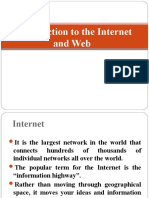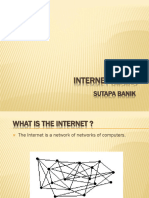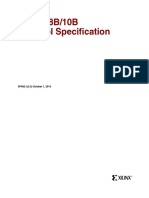0 ratings0% found this document useful (0 votes)
13 viewsproxy server-notes
Servers
Uploaded by
levi makokhaCopyright
© © All Rights Reserved
Available Formats
Download as PDF, TXT or read online on Scribd
0 ratings0% found this document useful (0 votes)
13 viewsproxy server-notes
Servers
Uploaded by
levi makokhaCopyright
© © All Rights Reserved
Available Formats
Download as PDF, TXT or read online on Scribd
You are on page 1/ 2
HTTP Proxy Servers
• Proxy server: Acts as an intermediary between a Wide Area Network
(WAN) (like the internet) and a Local Area Network (LAN).
• It processes requests from users, retrieves web pages from the internet,
and sends them back to the user.
• Caching: Pages retrieved from the internet are stored on the server,
making future requests for the same page faster as it retrieves them from
cache rather than re-fetching them from the internet.
The Internet
• It is global network that allows users to send and receive emails, browse
the web, and communicate using text, voice, and other multimedia.
• World Wide Web (WWW): Part of the internet where users access
information through a web browser (e.g., Microsoft Internet Explorer).
Websites
• Consist of multiple linked web pages (documents with text, images,
audio, or video). Websites can include hyperlinks to navigate between
different web pages.
• Example: A website like "www.hoddereducation.com" is made up of web
pages.
Hyperlinks
• Hyperlinks are clickable links (often blue and underlined text) that let users
navigate between web pages.
• URL: Uniform Resource Locator (URL) is the address used to find a resource
on the internet.
• Structure: protocol://site address/path/filename
• Protocol: Usually `http`
• Site address: Made up of the host computer name, domain name, and
country code (e.g., `.uk`, `.us`).
• Path: Refers to the specific page on the website.
• Filename: The file being accessed.
Accessing the Internet
• Internet Service Provider (ISP): A company that offers internet access for a
fee. Users sign up, receive login details (username and password), and
can access the internet and email accounts.
• Email: A service for sending and receiving electronic messages (text,
documents, files).
• Example of an email: `example1@yahoo.co.uk`
• Parts of an email:
i. Username: Part before `@`, e.g., `example1`
ii. Domain: Part after `@`, e.g., `yahoo.co.uk`
Types of Internet Access
1. Dial-up Internet Access:
• Slowest connection (about 60 kbps).
• Requires dialing a phone number provided by the ISP.
• Cons: Ties up the phone line while in use.
2. Cable Internet Access:
• Uses a cable network for faster access.
• Separate from the telephone line.
3. DSL Internet Access (Broadband):
• Fastest type of connection (at least 11,000 kbps).
• Uses a telephone line without blocking it.
• Allows fast data transfer for tasks like Voice over IP (VoIP) and online
chat rooms.
Intranets (Nxt Lesson)
You might also like
- 4 Introduction To Internet and Email - Information and Communication I and IINo ratings yet4 Introduction To Internet and Email - Information and Communication I and II33 pages
- Introduction To Internet and Internet Protocols100% (1)Introduction To Internet and Internet Protocols32 pages
- Internet Technology: Jinitha Obash NibmNo ratings yetInternet Technology: Jinitha Obash Nibm43 pages
- Mspc202 Topic5 Internet WWW Rev June2022No ratings yetMspc202 Topic5 Internet WWW Rev June202239 pages
- Cs8651 Internet Programming Unit I Website Basics, HTML 5, Css 3, Web 2.0 9No ratings yetCs8651 Internet Programming Unit I Website Basics, HTML 5, Css 3, Web 2.0 937 pages
- Search Engine: A Program That Searches Documents or Information Stored On WWW, Intranet or A Personal ComputerNo ratings yetSearch Engine: A Program That Searches Documents or Information Stored On WWW, Intranet or A Personal Computer33 pages
- Cs8651 Internet Programming Unit I Website Basics, HTML 5, Css 3, Web 2.0 9No ratings yetCs8651 Internet Programming Unit I Website Basics, HTML 5, Css 3, Web 2.0 937 pages
- ITCS 425: Introduction To Internet and World Wide WebNo ratings yetITCS 425: Introduction To Internet and World Wide Web37 pages
- Purposes of Internet: Communicate With PeopleNo ratings yetPurposes of Internet: Communicate With People3 pages
- 5.1_de2a5093-2bd8-4cff-bb6a-4584c0ab2de6No ratings yet5.1_de2a5093-2bd8-4cff-bb6a-4584c0ab2de618 pages
- Introduction To Internet: AIT2 IT Concept and SAD DevelopmentNo ratings yetIntroduction To Internet: AIT2 IT Concept and SAD Development26 pages
- Basic Internet Tutorial 1: How Does The Internet Work?100% (1)Basic Internet Tutorial 1: How Does The Internet Work?19 pages
- Introduction To The Internet and Web by Alok Gupta Assistant Professor Computer Science & EngineeringNo ratings yetIntroduction To The Internet and Web by Alok Gupta Assistant Professor Computer Science & Engineering21 pages
- Evaluation of Some SMTP Testing, Email Verification, Header Analysis, SSL Checkers, Email Delivery, Email Forwarding and WordPress Email ToolsFrom EverandEvaluation of Some SMTP Testing, Email Verification, Header Analysis, SSL Checkers, Email Delivery, Email Forwarding and WordPress Email ToolsNo ratings yet
- CHAPTER 7-ethics_and_ownership_simple_notesNo ratings yetCHAPTER 7-ethics_and_ownership_simple_notes27 pages
- Automated Systems in agriculture-homeworkNo ratings yetAutomated Systems in agriculture-homework3 pages
- 2018 Fifa World Cup Public Guidelines Guidelines For The Use of Fifa S 2850506 PDFNo ratings yet2018 Fifa World Cup Public Guidelines Guidelines For The Use of Fifa S 2850506 PDF31 pages
- Universal Tube & Rollform Equipment Corporation v. YouTube, Inc. - Document No. 25No ratings yetUniversal Tube & Rollform Equipment Corporation v. YouTube, Inc. - Document No. 2519 pages
- Short Notes On Webpage Programming Languages100% (1)Short Notes On Webpage Programming Languages5 pages
- Empowerment Technologies Quarter 1 Advanced Techniques Using Microsoft PowerpointNo ratings yetEmpowerment Technologies Quarter 1 Advanced Techniques Using Microsoft Powerpoint22 pages
- Overture Services, Inc. v. Google Inc. - Document No. 128No ratings yetOverture Services, Inc. v. Google Inc. - Document No. 12862 pages
- Open Source Internet Research Tool User Guide: Last Updated: 23/12/2016No ratings yetOpen Source Internet Research Tool User Guide: Last Updated: 23/12/201636 pages










































































































